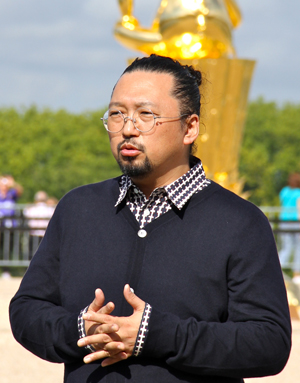
PARIS (AFP) – Paris’ top contemporary art fair, the FIAC, got off to an upbeat start on Thursday with galleries and dealers betting on brisk business despite the grim economic outlook.
One of Europe’s top art fairs, held on the heels of London’s Frieze last week, the FIAC brings together works from 168 galleries for four days under the ornate glass-and-iron vaults of the Grand Palais exhibition hall.
New York’s Pace Gallery, one of 27 U.S. outfits present, said the business outlook was good. “We have sold a lot of works,” its director Arne Glimcher told AFP. “We are feeling no impact from the financial crisis.”
Paris gallery Emmanuel Perrotin told AFP at the fair’s pre-launch on Wednesday it had already sold a work by the Japanese artist Takashi Murakami for “between two and three million” euros.
“I am surprised by visitors’ enthusiasm and curiosity, given the dark and depressing economic mood,” Paris gallery owner Kamel Mennour told AFP.
Canadian collector Francois Odermatt was showing off a blue sculpture by Britain’s Anish Kapoor to a group of friends. “I brought the same one in red at the Basel fair this year,” he quipped.
“People are fed up of waking up in the morning to see that the stock market has fallen yet again. At least when you buy an artwork, you get some enjoyment out of it, some pleasure.”
For his father, the former Paris gallery owner Herve Odermatt, China is playing a key role in keeping the art market afloat.
“There are more and more millionaires in China. You might have a luxury car, or diamonds – if you don’t have art on your walls, you’re seen as a
peasant.”
After France’s 54 galleries, the United States has FIAC’s largest foreign contingent, ahead of Germany with 21 galleries, Italy with 12, Belgium with 11, Britain with 10 and Switzerland with nine.
FIAC director Jennifer Flay said there was “a big buzz” ahead of this year’s edition.
“Since 2008 when the world economy trembled, FIAC has stood up extremely well,” she told AFP. “People are expecting strong business here.”
At its peak in 2007 the global art market was worth around $65 billion, double the figure from five years earlier, according to the research firm Arts economics.
Prices slumped by as much as 50 percent during the financial crisis as works were unable to find buyers.
But the contemporary art market bounced back in 2010, when the world’s largest auction house, London-based Christie’s, saw its sales of contemporary art jump almost 150 percent over the previous year.
Early signs for 2011 suggest the market remains buoyant, although observers are waiting for the outcome of the modern art auctions held each autumn in New York for a firmer picture.
“The FIAC is a good barometer, but we’ll have a better overall view after the New York auctions next month,” said Guillaume Cerruti, vice-president of Sotheby’s Europe.
# # #


